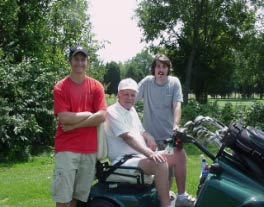CASE STUDY: Hamilton County, Ohio
HELPING DREAMS COME TRUE
Innovative SoloRider golf car helps mobility impaired enjoy the gamewhile
creating incremental revenues for Cincinnati area courses.
The Round of His Dreams:
Jack Eick with grandsons Michael (l) and Mark
Jack Eick, an 83-year-old grandfather from Cincinnati, had a dream. For most grandfathers like Eick who love golf, it was a simple dream. For Eick, it was more complicated.
“I wanted to play golf with my grand kids, just one time,” says Eick, who was an avid golfer until stricken by peripheral neuropathy, a neurological disease affecting the muscle tissue, which makes it impossible for Eick to walk and play golf.
Even though he could no longer play, Eick stayed close to the game by attending tournaments near his home. A few years ago, during a Senior PGA event, Eick met Dennis Walters. Walters was an aspiring professional golfer before an accident left him paralyzed below the waist. After Walters’ clinic, in which he demonstrated trick shots and imparted an inspiring message, Eick told Walters about his dream.
When Walters suggested to Eick that he look into the single-rider golf cars coming onto the market, the hope began to return to the grandfather’s dream. On a beautiful August day three years ago, Eick played golf with grandsons Michael and Mark at the Meadow Links and Golf Academy in Cincinnati.
For that experience, Eick has not only his own dedication, but also the enterprising efforts of the Hamilton County Park District and the SoloRider golf car to thank.
SoloRider Delivers Incremental Revenue for Hamilton County
Doug Stultz, a PGA professional and golf manager for the Hamilton County Park District’s seven courses, met Eick when the World War II veteran and retired General Electric executive convinced him to help him make a video showing physically challenged golfers using the SoloRider.
The only problem was that Stultz didn’t have an extra $8,000 in his budget for a SoloRider. But that sort of detail doesn’t stop Eick.
Through a friend at his church, Eick made a connection with local businessman Buddy La Rosa, who owns a chain of pizza parlors. A couple of days after the presentation, La Rosa sent a check for $8,000 to buy the SoloRider.
By this time, Stultz was convinced that making golf accessible to players with limited mobility was good for Hamilton County and the game. He was also convinced more SoloRiders were needed. So he got creative with his financing, too, and found enough grant money from the state of Ohio to purchase another SoloRider. Now he says his goal is to get at least one single-rider for each of the seven courses in the Hamilton County system.
Stultz says there’s now an “active crowd” of 25 to 30 new golfers who are coming to the Hamilton County courses and using the single-rider cars to play and hit balls on the range. He estimates they played 100-125 rounds last year and probably accounted for at least twice that many additional rounds based on the able-bodied players they brought with them to the course.
When he adds the greens fees, range balls, F&B and merchandise, Stultz estimates the incremental revenues come to somewhere between $5,400 and $6,800 for the year.
In the next couple of years, as the word gets around, Stultz thinks that “active” group of players with a disability playing the Hamilton courses will grow to 50 to 75, which will add more needed dollars to put back in the courses.
Cincinnati Discovers ‘Trickle-Down’ Benefits of SoloRiders
Hamilton County’s experience inspired the city of Cincinnati to follow suit. It now has three SoloRiders with one more on the way, compliments of a grant from the USGA.
Steve Pacella, regional manager for Billy Casper Golf, which manages Cincinnati’s eight public courses, cites a “trickle-down economic effect” of single-riders similar to what Hamilton County experienced.
“The direct revenue they generate isn’t as significant as the indirect revenue,” he said. “If I have three of these cars available, that may inspire a league of players that we didn’t have before. If there’s a kid with a disability who wants to play, that may get his grandma and grandpa out here.”
Pacella adds that the Cincy courses also get a lot of players who want to use the single-riders just to hit balls on the range.
“Do they pay for themselves? The answer is yes,” Pacella says. “But it’s not necessarily in the $12 cart rental fees. It’s everything else they generate. The additional golfers, the additional range balls, the F&B.
“But to be honest, we’re not worried about the dollars we recover from the carts,” he adds quickly. “Whether they go out one time or 100 times, we know we’re doing the right thing and helping people enjoy the game.”
No Price Tag on Joy
Stultz thinks that the ROI on the purchase of single-rider golf cars should be “at least a breakeven situation” for most public courses and military facilities.
Of course, if the course owner/operator gets creative and finds a local pizza magnate or some grant money (which is more readily available than many might think), all the incremental revenues from green fees, range balls and F&B go straight to the bottom line.
But, as Stultz says, he isn’t a proponent of accessible golf because of the potential financial benefit.
“We didn’t get into this with the idea of financial gain. I think golf is a game that should be available to everyone, and as a golf professional, I think it’s our job to encourage that,” he says. “When you see some of these guys out there playing, maybe for the first time in years, and they’re having the time of their life, you just can’t put a dollar figure to that.”

